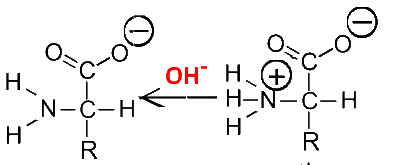







If the $pH$ of the medium is low ( $[H_3O^+]$ high), the carboxylate ion becomes a neutral carboxyl group, the ammonium ion remains in the positive form:

On the other hand, if the $pH$ of the medium is high ($ [OH^-] $ high), the ammonium ion turns into a neutral amino group, the carboxylate ion remains in negative form:

The same applies to ammonium or carboxylate groups in the side chains, for example:

We see that the overall charge of the amino acid depends on the $pH$ of the medium as well as on the functions present in the side chain: - At low pH and side chain already "acid" (presence of carboxylic acid function), the amino acid is globally positively charged. - At low pH and side chain already "basic" (presence of amine function or the like), the amino acid is generally negatively charged. - At $ pH \approx 7$ and neutral side chain, the amino acid is globally neutral.
The isoelectric point ($ pI $) is the $ pH $ where the amino acid is globally neutral. - For basic amino acids ("basic" side chain), $ pI \approx 9.5$ - For acidic amino acids ("acid" side chain), $ pI \approx 3$ - For neutral amino acids ("neutral" side chain), $ pI \approx 6$
If the side chain of the amino acids only has atoms $ C $ or $ H $, the difference of → electronegativity is low, the interactions of the → Van der Waals type between these side chains are very weak :

If the side chain of the amino acids has strong polar groups, ($ O-H $, $ -NH_2 $ ...), the → dipole-dipole or → H-bond interaction between these side chains can be very strong:

Nonpolar amino acids have low non-polar side chains. Polar amino acids have strong polar side chains.
Lysine is .......... Valine is .......... Serine is .......... Aspartic acid is ..........